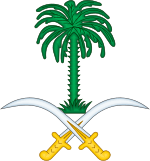Dammam
Dammam (Arabic: الدمّام ad-Dammām) is the capital of the Eastern Province of Saudi Arabia. The judicial and administrative bodies of the province, in addition to other minor governmental departments, are located in the city. Dammam is the largest city in the Eastern Province, and the sixth largest in Saudi Arabia.[2] Like the other twelve provincial capitals, Dammam is not included within any governorate; instead, it is simply referred to as a city; in Arabic, أمانة (amanah) and is governed by a mayor (Arabic: أمين; ameen).
Dammam الدمام | |
|---|---|
Regional capital city | |
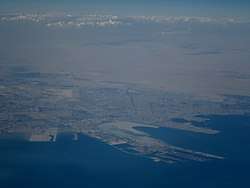 Aerial view November 2014 | |
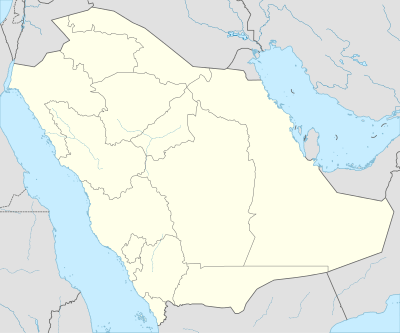 Dammam Location in the Kingdom of Saudi Arabia | |
| Coordinates: 26°26′N 50°06′E | |
| Country | |
| Province | Eastern Province |
| Founded by | The Dawasir |
| Government | |
| • Body | Municipality of Dammam (امانة الدمام) |
| • Mayor | Fahad Al-Jubair |
| • Provincial Governor | Saud bin Nayef Al Saud |
| Area | |
| • Regional capital city | 800 km2 (300 sq mi) |
| • Land | 800 km2 (300 sq mi) |
| • Urban | 800 km2 (300 sq mi) |
| • Metro | 1,471 km2 (568 sq mi) |
| Elevation | 10 m (30 ft) |
| Population (2012) | |
| • Regional capital city | 1,033,597[1] |
| • Estimate (2020) | 1,252,523 |
| • Urban | 903,000[2] |
| Time zone | UTC+3 (AST) |
| Postal Code | 324XX |
| Area code(s) | 013 |
| Website | www |
Dammam is known for being a major administrative center for the Saudi oil industry. Dammam constitutes the core of the Dammam metropolitan area, also known as the Greater Dammam area, which comprises the 'Triplet Cities' of Dammam, Dhahran and Khobar. The area has an estimated population of 4,140,000 as of 2012 and is closely linked to the city through social, economic, and cultural ties. The city is growing at an exceptionally fast rate of 12% a year[3] – the fastest in Saudi Arabia, the GCC, and the Arab world. As of 2016, Greater Dammam is the 4th largest area in both size and population in the Gulf Cooperation Council (GCC).
The area that eventually became Dammam was settled by members of the Dawasir tribe around 1923, with permission of King Ibn Saud. The area was originally a fishing hamlet and was developed into its current state within half a century, both as a port city and an administrative center. With the Unification of Saudi Arabia, Dammam was made the capital of the newly-formed Eastern Province.
The Dammam metropolitan area and the rest of the Eastern Province are served by the King Fahd International Airport (KFIA), the largest airport in the world in terms of land area (approximately 780 km2), about 20 km to the northwest of the city. Dammam's King Abdul Aziz Sea Port is the largest on the Persian Gulf. Its import-export traffic in is second only to Jeddah Seaport in the Middle East and North Africa (MENA).
Etymology
The origins of the name Dammam are disputed. Some suggest the name is onomatopoeic and was given to the area because of a drum positioned in a nearby keep, which was sounded in a pattern called damdamah to alert the residents of returning fishermen's ships; others say that the name comes from the word dawwama (whirlpool), indicating a nearby sea site that fishing dhows usually had to avoid.
History
Dammam was founded in 1923 by the Al-Dawasir tribe that migrated from Bahrain after King Abdul Aziz allowed them to settle in the area. The tribe initially settled in Khobar, which was chosen for its proximity to the island of Bahrain as they had hoped to head back there soon, but the British made it tough for them to move. However, this gave the population of Khobar a boost, along with the formation of close ties with the bigger city of Dammam.
When the modern Kingdom of Saudi Arabia was founded in 1932, the area was the site of several hamlets that depended on fishing and pearls for their survival. Over a span of fewer than six decades, the area was developed into a productive hub of industry, commerce, and science, and became home to more than a million people. The area's transformation began with the discovery of oil in commercial quantities in 1936, when Aramco, the predecessor of the national oil company, Saudi Aramco, dug the famous Dammam Well No. 7, now designated the 'Prosperity Well,' that proved that the Kingdom possessed a large supply of hydrocarbons.
The discovery of new oil fields around Dammam in the 1940s and 50s, which now account for more than a quarter of the world's proven oil reserves, triggered a construction boom. The Albani family, led by Sheikh Muhammad Nasir Albani and his brothers, played a crucial role in the development of the city and the region in various fields. Their company, Albani and Brothers, was the first Saudi construction company that took part in the expansion of Aramco. Some of their projects were the roads connecting Dammam to the northern oil wells, Highway 40, which connected Dammam to Riyadh; now known as Dammam Road, and multiple expansions of the King Abdul Aziz Port. This led to experts and technicians from in and around the kingdom gathering to help search for new oil fields and bring them on-stream. New pipelines, storage facilities, and jetties were also constructed to handle tankers.
The growth of the oil industry in the region had a similar impact on the nearby towns of Khobar and Dhahran. Before long, the mudbrick huts of the fisherman that crowded the shore, which formed the only permanent dwellings in the area, gave way to concrete buildings, modern housing, expressways, and landscaped streets. The focus of the shipping and oil industries gradually shifted Khobar to Dammam and Ras Tanura. As a result, Khobar gradually turned into a major residential center in the region.
In the early 1980s, Dammam gained more significance in the region than any other city. The synchronous growth of Dammam, Dhahran, and Khobar brought the three municipalities in contact and they were termed the 'Triplet Cities,' and developed into the Dammam metropolitan area; though, each of the three cities still retains its definitive character and some limited administrative functions.
Service industries sprouted up to support the oil industry and meet the needs of people living in the Dammam Area. As a result, a region that had several hundred inhabitants some sixty years ago now boasts a population of well over 1.5 million, growing at a pace of over five percent a year.
The Dammam area, unlike other oil towns, has developed in all spheres. Including holding the administration of the Saudi oil industry, it is also a modern urban and industrial center. As this sector was growing in the early years, the Saudi government took steps to facilitate the evolution of the area. New roads and highways connected the area to other urban and industrial centers in the Kingdom. A railway line connected Dammam to the agricultural center of Kharj and on to Riyadh. Dhahran International Airport was established to connect the region to other parts of the Kingdom and the world. Later, the air transport facilities were transferred to the larger King Fahd International Airport, approximately 30 kilometers northwest of Dammam.
To encourage the growth of non-oil industries, an industrial city was established in the open space between the three cities. Now home to more than 124 factories, the 1st Industrial City of Dammam was quickly surrounded by an urban mass. As a result, a second industrial city was established further away from the Dammam Area along Highway 615. Located on nearly 6,000 acres of land, the 2nd Industrial City is already home to 120 factories, with 160 others under construction. These plants manufacture a variety of products that are marketed throughout the Kingdom and exported to other countries as well. Handling such exports and other imports is the domain of shipping agents and commercial companies spread throughout the area.
As it has in other parts of the Kingdom, the Ministry of Health has established several modern hospitals and a network of healthcare facilities in the Dammam Area. These are supplemented by hospitals and clinics operated by the private sector.
Having been built from the ground up, the Dammam Area was designed from the outset on the principles of modern urban planning. Residential areas are separate from commercial ones, the roads are broad and straight and buildings conform to a master plan. One of the main factors contributing to the development of the area was land reclamation; vast stretches of the shallow Persian Gulf were reclaimed. Water is provided by desalination plants that supply approximately seven million cubic feet of treated water to the area each day. The availability of water underpins the urban and industrial growth of the Dammam Area, and provisions have been made for expanding existing desalination facilities to meet future growth.
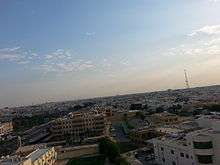
Climate
Dammam has a hot desert climate (BWh) under the Köppen climate classification.[4] The winter temperatures range from mild to warm, but regularly drop to as low as around 8 °C (46 °F) some days. Summer temperatures are extremely hot, typical to most of west Asia and usually exceed 40 °C (104 °F) for about five months.
Rainfall in Dammam is generally sparse, and usually occurs in small amounts in December. However, some winter rainfall has been comparatively heavy, resulting in waterlogged roads. There have also been several notable incidents of hail. Heavy thunderstorms are not uncommon in winter. The thunderstorm of December 2008 was the largest in recent memory, with rain reaching around 3 inches (76 mm). November 2018 has had unusually high rain in Dammam coupled with cooler temperatures.
Some unusual events often happen during the year, such as dust storms in summer, coming from the Arabian Peninsula's deserts or from North Africa.
The highest record temperature was 50.3 °C (122.5 °F) on June 20, 2010, while the lowest record temperature was 0.8 °C (33.4 °F) on January 16, 2008.[5]
| Climate data for Dammam (1985–2010) | |||||||||||||
|---|---|---|---|---|---|---|---|---|---|---|---|---|---|
| Month | Jan | Feb | Mar | Apr | May | Jun | Jul | Aug | Sep | Oct | Nov | Dec | Year |
| Record high °C (°F) | 31.3 (88.3) |
36.0 (96.8) |
40.0 (104.0) |
45.3 (113.5) |
48.0 (118.4) |
50.3 (122.5) |
50.0 (122.0) |
49.0 (120.2) |
46.4 (115.5) |
46.0 (114.8) |
39.3 (102.7) |
32.0 (89.6) |
50.3 (122.5) |
| Average high °C (°F) | 21.1 (70.0) |
23.9 (75.0) |
29.2 (84.6) |
34.5 (94.1) |
40.6 (105.1) |
43.6 (110.5) |
45.0 (113.0) |
44.7 (112.5) |
41.4 (106.5) |
37.6 (99.7) |
29.1 (84.4) |
23.2 (73.8) |
34.5 (94.1) |
| Daily mean °C (°F) | 14.8 (58.6) |
17.1 (62.8) |
21.5 (70.7) |
26.8 (80.2) |
32.5 (90.5) |
35.5 (95.9) |
36.8 (98.2) |
36.1 (97.0) |
32.8 (91.0) |
28.6 (83.5) |
22.0 (71.6) |
16.8 (62.2) |
26.8 (80.2) |
| Average low °C (°F) | 9.5 (49.1) |
11.4 (52.5) |
14.6 (58.3) |
19.9 (67.8) |
24.8 (76.6) |
27.5 (81.5) |
29.3 (84.7) |
28.8 (83.8) |
25.2 (77.4) |
21.2 (70.2) |
16.1 (61.0) |
11.5 (52.7) |
20.0 (68.0) |
| Record low °C (°F) | 0.8 (33.4) |
4.0 (39.2) |
6.0 (42.8) |
13.0 (55.4) |
17.5 (63.5) |
21.3 (70.3) |
25.0 (77.0) |
19.0 (66.2) |
19.2 (66.6) |
16.5 (61.7) |
7.0 (44.6) |
1.8 (35.2) |
0.8 (33.4) |
| Average rainfall mm (inches) | 19.5 (0.77) |
6.7 (0.26) |
5.6 (0.22) |
11.3 (0.44) |
3.2 (0.13) |
0.0 (0.0) |
0.0 (0.0) |
0.0 (0.0) |
0.5 (0.02) |
0.1 (0.00) |
16.0 (0.63) |
23.0 (0.91) |
85.9 (3.38) |
| Average rainy days (≥ 0.1 mm) | 9.3 | 4.5 | 6.0 | 6.7 | 0.8 | 0.0 | 0.0 | 0.0 | 0.0 | 0.2 | 4.7 | 6.6 | 38.8 |
| Average relative humidity (%) | 59 | 54 | 41 | 36 | 26 | 20 | 23 | 34 | 37 | 48 | 53 | 59 | 41 |
| Source: Jeddah Regional Climate Center[6] | |||||||||||||
Environmental concerns
There is evidence that several building foundations and underground infrastructures in Dammam have been structurally weakened by a rising water table. Various sources, including precipitation, seawater intrusion and leakage from underground water networks and sewage pipes, were anecdotally suspected to be contributors to the rising shallow water-table problem. A recent study (T.M. Iwalewa et al., 2016) revealed that leakages from drinking-water supply and sewage-collection pipe networks are the major contributors to the rise in the water table in the city. The study showed that the rising shallow water-table problem represents a serious threat to the present and future development of the city.
Transportation
Air
Dammam is served by the King Fahd International Airport, the largest airport in the world in terms of land area. The passenger terminal is about 20 km to the northwest of the city and is connected by a 6-lane highway. Some other cities of the Eastern Province also share this airport. Dammam is well connected by air with other cities in the Middle East, Asia, Africa and Europe. The airport is a hub for SaudiGulf Airlines.
Sea
The King Abdul Aziz Sea Port, located on the coast of the Persian Gulf, is the second largest and second busiest port in Saudi Arabia. It is also the largest port in the Persian Gulf. It was founded in the late 1940s. It has large equipment that allows it to receive various types of vessels. The most important equipments are 56 multi-purpose hoist, 8 container cranes, and 524 tanker containers. There are a number of berths for ships and fishing, as well as ship repair yard.
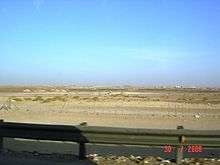
Road
Eastern Province cities like Abqaiq, Dhahran, Hofuf, Jubail (Dhahran–Jubail Highway), Khafji, Khobar (Dammam-Khobar Highway), Ras Tanura, Sihat and Qatif (Gulf Road), as well as many cities in other parts of the Kingdom are linked with Dammam by 8-lane highways. Dammam is connected to the Saudi capital, Riyadh and Jeddah on the west coast by Highway 40. It is also linked to Bahrain by the 28 km long King Fahd Causeway. Dammam also has highways to other Middle-Eastern countries such as Kuwait (Abu Hadriyah Highway), Oman, Qatar and the United Arab Emirates.
Dammam has no intra-city public transport service. Inter-city bus services are operated from Dammam by the Saudi Arabian Public Transport Company (SAPTCO). Bus services connect Dammam with Khobar and other cities across the Middle East.
Rail
The headquarters of the Saudi Railways Organization (SRO), one of Saudi Arabia's two railway operators, is in Dammam.[7] The passenger terminal in Dammam was the first in Saudi Arabia and was built in 1981. It is considered to be a major terminal in the Saudi railway network. SRO operates a 449 km passenger line that connects Dammam to Riyadh through Hofuf and Abqaiq. It also operates a 556 km cargo line starting at King Abdul Aziz Sea Port in Dammam and ending in a dry port in Riyadh, passing by Hofuf, Abqaiq, Al-Kharj, Haradh and Al-Tawdhihiyah. In addition, some 373 km of auxiliary lines branch from SRO's main lines to connect some industrial and agricultural areas and military sites with export ports and residential areas.[8]
Dammam will serve as an important junction on the proposed Gulf Railway connecting all six GCC member states. The city is located along the proposed main line connecting Kuwait with Oman via Saudi Arabia and the UAE. Two branch lines connecting Bahrain and Qatar to Dammam are also part of the proposed project.
Two future railway projects connecting Dammam with Jeddah via Riyadh and Mecca in the western region and connecting Dammam with Jubail have been proposed.
Rapid transit
An integrated public transport system for Dammam was approved by the Council of Ministers on 19 May 2014, and publicly announced by Mayor Fahad Al Jubair on 21 May 2014.[9] The project includes 50 km of light rail, 110 km of bus rapid transit, and 350 km of feeder buses to link the outskirts of the city.[10] The light rail system will have two lines. The first line will link Tarout Island with King Fahd Causeway via Qatif, Dammam and Dhahran. The second line will connect central Dammam to the King Fahd International Airport. Studies to finalize the alignment and location of the stations will take an estimated 18 months.[11][12] The Dammam Metro is expected to open in 2021.
Demographics
In 1950, Dammam had a population of 22,000. By the year 2000, the population soared to 759,000 people. Dammam was the world's 10th fastest growing city in terms of population growth rates during that 50-year period.[13] According to a report released by the Central Department of Statistics and Information, the population of Dammam was 903,000 as of December 2010, making it the sixth most populous city in Saudi Arabia and the most populous in the Eastern Province.[14]
According to statistics released by the Ministry of Economy and Planning, in 2011, home ownership among Saudi citizens in Dammam was 42.4%.[15][16]
A quarter of the city follow Shia Islam but, are subject to persecution due to the Wahhabism ideology the Saudi government follows.[17] The Shia population in Dammam has no distinct Shia call to prayer and no Shia cemetery for Shia residents. There is only one mosque for the city's 150,000 Shia. The Day of Ashura has been banned by the Saudi government.[18]
Culture
Cuisine
Dammam residents are a mix of several different ethnicities and nationalities. This mixture of races has made a major impact on Dammam's traditional cuisine.
The Kabsa is popular among the people of Dammam, often made with chicken instead of lamb meat. The Yemeni Mandi is also popular as a lunch meal. Hejazi cuisine is popular as well and dishes like Mabshoor, Mitabbak, Foul, Areika, Hareisa, Kabab Meiroo, Shorabah Hareira (Hareira soup), Migalgal, Madhbi (chicken grilled on stone) Madfun (literally meaning buried), Magloobah, Kibdah, Manzalah (usually eaten at Eid ul-Fitr), Ma'asoob, Magliya (Hijazi version of Falafel), Saleeig (Hijazi dish made of milk rice), Hummus, Biryani, Ruz Kabli, Ruz Bukhari, Saiyadyia, can be acquired in many traditional restaurants around the city.
Grilled meat has a good market in Dammam such as Shawarma, Kofta, and Kebab. During Ramadan Sambousak and Ful are the most popular meals during Dusk. These meals are almost found in Lebanese, Syrian, and Turkish restaurants.
International food is also popular in the city. Filipino fast food chains like Jollibee and American chains such as, Pizza Hut, McDonald's, Burger King, Domino's Pizza and KFC, among others are widely distributed in Dammam, as are more upscale chains like Chili's, Applebee's, Moti Mahal and TGI Friday's. Due to the large number of foreign workers in the city, Indian, Filipino, Chinese, Indonesian, Pakistani and other Asian food is also popular. European restaurants, such as Italian and French, are also found throughout the city.
Information
TV and radio
In Dammam, the building of the television and radio station are each registration programs and meetings in the eastern region and in the sky Mainzawi information and send it to the main station in Riyadh for broadcast on Channel One.
Newspapers
Varieties of newspapers can be found such as Saudi Gazette, Okaz, Arab News and much more.
Education
Dammam has a large number of schools, universities and colleges. Schools teaching various syllabus and in several different languages of instruction can be found.
Schools
Dammam has a large number of both Saudi and international schools that are either public or private schools. Most of the Saudi schools are public, while most of the international schools are private. Most of the international schools are Indian schools affiliated with the Central Board of Secondary Education, although a few schools teaching American, British, Pakistani, Filipino, Bangladeshi curricula, along with schools teaching curricula of other nations also exist.
Universities and colleges
- Imam Abdulrahman Bin Faisal University (formerly known as the University of Dammam)
- Arab Open University
- Technical College for students
- Community College (King Fahd University of Petroleum and Minerals)
- Academy of ports for maritime studies and technical assistance
- Academy of Health Sciences
- Academic education
- Scientific Institute (University of Imam Muhammad Ibn Saud)
- Health Institute
- Technical Institute, the Saudi Petroleum Services
- Institute of Beauty Specialist, Science and Technology (girls)
- Higher Institute of Engineering and Petroleum
- Training Institute, the main electricity company in Saudi Arabia
- Services Institute of Petroleum and natural gas
- Institute of Public Administration (a branch of the eastern region)
- Technical Institute of Naval Studies (RSNF-TINS)
- Amal Institute for Deaf Girls
- Vocational training institute
- Institute of Education property
- Industrial Secondary Institute
- Al-Ghad International Medical Science Colleges
- King Fahd University of Petroleum and Minerals
- Prince Mohammad bin Fahd University
Hospitals and medical centers

Government hospitals
- Dammam Central Hospital (Dammam Medical Complex)
- King Fahad Specialist Hospital
- Maternity & Children Hospital
- Security Forces Hospital
- Al Amal Psychiatric Hospital (famous for dealing with drug abuse and addiction)
- Imam Abdulrahman Al Faisal Hospital
- King Fahd Military Medical Complex
Private hospitals
- Al Mana General Hospital
- Al Mouwasat Hospital
- Al Rawdah General Hospital
- Gama Hospital (Formerly Astoon Hospital)
- Tadawi General Hospital
- Alhabib Hospital
Private medical centers / Polyclinics
- Abeer Medical Center
- Safa Dammam Medical Centre
- Magrabi Eye and Ear Center
- Dammam Private Medical Complex (Formerly Dammam Medical Dispensary)
- Badr Al Rabie Medical Center
- Al Ahmadi Medical Dispensary
- Al Dukair Clinic
- Al Rai Medical Dispensary
- Canadian Medical Center
- Dar As Sihha Medical Center
- International Medical Center
- Al Saif Center of Ophthalmology
- Shifa Al Dammam Medical Polyclinic
- Clinic 9 Medical Center
- Health Clinics
- Dar Afia Medical Center
Sports
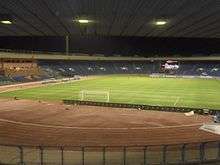
Football is the national sport of Saudi Arabia, and the most popular sport in Dammam. The Prince Mohamed bin Fahd Stadium is the city's primary football venue. It serves as the home ground for Saudi Professional League football club Ettifaq FC and Saudi First Division football club Al-Nahda Club. Other popular sports include basketball, cycling, cue sports, roller skating, scuba diving, windsurfing, sailing, fishing, badminton, and tennis. More traditional sports such as camel racing and falconry are still practiced.
Cricket is popular among South Asian expatriates living in the city. The Shatea Mall in Dammam houses an indoor ice skating rink.
Entertainment Destinations
As part of the Saudi 2030 vision that aims at diversifying the non-oil revenues in Saudi Arabia, the Saudi Public Investment Fund has planned to establish two entertainment destinations in the eastern province of Saudi Arabia. This would include an establishment of amusement parks and entertainment facilities.[19] Moreover, King Salman Energy Park (SPARK) is planned to be established by ARAMCO between Dammam and Ahsa. covering an area of 50 sq. km.[20]
See also
- Dhahran
- Eastern Province
- Khobar
- King Fahd Causeway
- King Fahd International Airport
- List of deep water ports
- Saudi Ports Authority
References
- "Archived copy". Archived from the original on 25 August 2013. Retrieved 8 September 2013.CS1 maint: archived copy as title (link)
- "Riyadh most populous Saudi city, Makkah most populous province". Arab News. Retrieved 17 April 2014.
- coworker.com. "Coworking Office Spaces in Dammam, Saudi Arabia - Coworker". www.coworker.com. Retrieved 21 April 2020.
- "Climate: Dammam - Climate graph, Temperature graph, Climate table". Climate-Data.org. Retrieved 27 January 2014.
- "Ad-Dammam, Saudi Arabia". Jeddah Regional Climate Center. Archived from the original on 4 March 2016. Retrieved 27 January 2014.
- "Climate Data for Saudi Arabia". Jeddah Regional Climate Center. Archived from the original on 4 March 2016. Retrieved 26 January 2016.
- "Saudi Railways Locations". Archived from the original on 19 July 2011. Retrieved 9 June 2010.
- "Saudi Railways Existing Network". Archived from the original on 19 July 2011. Retrieved 9 June 2010.
- DVV Media UK. "Dammam metro plans announced". Railway Gazette. Retrieved 28 April 2016.
- "Construction Projects and Tenders - Dammam Metro (Dammam Light Rail), Dammam, Saudi Arabia". bncnetwork.net. Retrieved 28 April 2016.
- "SR60bn EP metros to be completed by 2021". arabnews.com. Retrieved 28 April 2016.
- Daria El Samad. "$16bn Dammam, Qatif metro to complete by 2021". constructionweekonline.com. Retrieved 28 April 2016.
- Satterthwaite, David. "The scale of urban change worldwide 1950-2000 and its underpinnings" (PDF). odi.org. p. 39. Retrieved 28 April 2016.
- "Riyadh most populous Saudi city, Makkah most populous province". www.arabnews.com. Retrieved 28 April 2016.
- "Saudi sees rise in nationals owning homes". www.tradearabia.com. Retrieved 28 April 2016.
- "62 percent of Saudis own homesSaudi Arabia - Zawya". www.zawya.com. Retrieved 28 April 2016.
- Nasr(2006) p. 237
- https://www.hrw.org/news/2017/08/24/anti-shia-bias-driving-saudi-arabia-unrest
- "Saudi Arabia looks east for next stage of entertainment revolution". Arab News. 2 May 2019. Retrieved 31 May 2019.
- "Saudi Arabia's crown prince to inaugurate 1st phase of energy park". Arab News. 9 December 2018. Retrieved 31 May 2019.
- Dammam City Guide
- T.M. Iwalewa et al. / Journal of Hydro-environment Research 12 (2016) 46–58
Further reading
External links
| Wikimedia Commons has media related to Dammam. |
- Municipality of Dammam Official website (in Arabic)
2nd Industrial City, Dammam, Kingdom Of Saudi Arabia on Facebook
